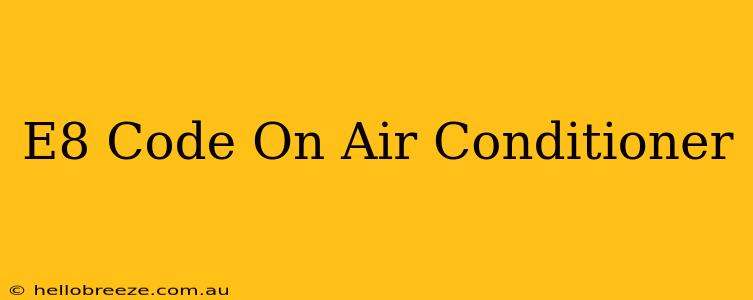Is your air conditioner displaying an E8 error code? This frustrating situation leaves you sweating (literally!) and searching for answers. Don't worry, we're here to help you decode this cryptic message and get your cool air flowing again. This guide will walk you through understanding the E8 error, troubleshooting common causes, and potential solutions.
Understanding the E8 Air Conditioner Error Code
The E8 error code isn't a universal standard across all air conditioner brands. The meaning of E8 varies significantly depending on the manufacturer. While some brands might use it to indicate a specific problem, others may not even utilize this code. Therefore, the first crucial step is to identify your air conditioner's brand and model.
This information is typically found on a sticker located on the unit itself. Once you have this information, consult your air conditioner's user manual. The manual will provide the most accurate interpretation of the E8 error code for your specific model.
Common Causes of E8 Error Codes (Manufacturer-Specific)
While a definitive answer requires checking your manual, some common issues associated with error codes similar to E8 (or codes in that numerical range) include:
1. Problems with the Outdoor Unit:
- Refrigerant leaks: A low refrigerant level is a common culprit behind many AC issues. Refrigerant leaks can be caused by damaged lines, faulty connections, or other component failures. This is a serious problem that requires professional attention.
- Compressor issues: The compressor is the heart of your air conditioner, responsible for circulating the refrigerant. An E8 code might indicate a malfunctioning compressor, which could result from overheating, electrical problems, or general wear and tear. Compressor repair or replacement typically requires professional HVAC technicians.
- Fan motor problems: The outdoor unit's fan motor is vital for dissipating heat. If this motor fails or malfunctions, it can trigger an error code. This is another area where professional help is often recommended.
2. Issues with the Indoor Unit:
- Communication Problems: Some E8 codes might relate to communication issues between the indoor and outdoor units. This could stem from faulty wiring, a bad circuit board, or even a loose connection.
- Sensor malfunctions: Various sensors monitor the air conditioner's operation. A malfunctioning sensor can lead to false error codes.
Troubleshooting Steps: Before You Call a Technician
Before panicking and calling an expensive technician, try these basic troubleshooting steps:
- Check the Power: Ensure the air conditioner is properly plugged in and that the power supply is functioning correctly. Check the breaker box for any tripped breakers.
- Check the Filters: Clogged air filters restrict airflow, causing the unit to overheat and potentially trigger an error code. Clean or replace your air filters.
- Examine the Outdoor Unit: Look for any obvious obstructions blocking airflow around the outdoor unit, such as leaves, debris, or overgrown vegetation. Ensure that the condenser coils are clean.
When to Call an HVAC Technician
If the simple troubleshooting steps don't resolve the E8 error, it's time to call a qualified HVAC technician. Attempting to repair complex AC problems yourself can be dangerous and may void any warranties. Professional help is necessary for issues such as refrigerant leaks, compressor problems, and electrical faults.
Choosing a reputable technician is vital. Ask for recommendations, check online reviews, and ensure the technician is licensed and insured.
Remember, the key is to consult your air conditioner's manual to get the manufacturer's specific interpretation of the E8 error code. This will greatly aid in accurate troubleshooting and efficient repair. Stay cool!

